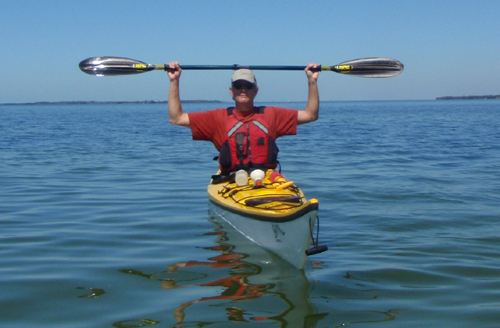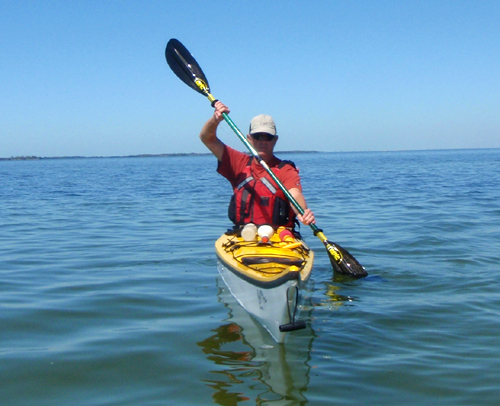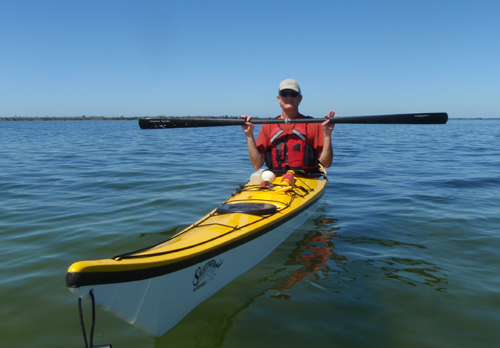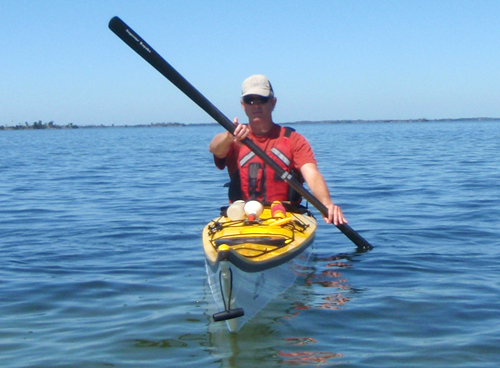Greenland paddle / Wing paddle
Posted by Greg on February 12, 2012Q: You have stated that the Greenland Paddle (GP) can act as a wing when the GP is used in a high wing type stroke. Have you done a test in your fast kayak, GP vs wing to determine advantages of one or the other with respect to efficiency and/or speed in non racing situations, eg., outings from 5 to 15 miles?
I have acquired both a wing (Onno) and a GP (Novorca) in the last year and have been learning both. At 4.2 kts, my traveling speed, the GP feels more efficient, but I can go at least 0.2 kts faster with the wing. Jerry
A: Jerry, Although I realize that you said non-racing situations, let me use that as an example, first, as it helps to clarify the issue.
To generalize, a racer is often trying to maximize speed over distance usually with an extremely light, unladen kayak. A sea kayaker is often trying the maximize the number of “miles per Snickers bars”, often with a heavy or gear-laden kayak, day after day. These are related, but are very different things and need to be viewed separately.
In a racing situation — very light kayak, 10 miles or less, using a very high stroke, I’m about 1.5 – 2 minutes per mile faster with my wing than with a GP. That’s not much for touring but is an eternity for racing. Unfortunately this is not a perfect test since my current “go-fast” kayaks have a fairly high foredeck that makes it difficult to fully bury the blades of my GP at the catch. I have won local races with a GP over wings, but if I want my best time I use a wing.
You don’t get something for nothing. The speed comes wit h a price.
h a price.
With a wing (or other “Euro” paddle) you hold the paddle such that if you were to place the center of the shaft on your head, your elbows make a 90 degree, or slightly less, bend. To achieve a vertical stroke you must lift your arms fairly high, and that’s the rub. Even if you have the lightest–most expensive paddle available, mere ounces, you are still lifting many pounds on each stroke — the weight of your arms. That’s not to say that you shouldn’t use a light paddle (I buy the lightest I can afford) but you also have to understand the role of your technique in the equation.
With a GP, your hands are much closer together. You do need to ensure that your paddle shaft is long enough to generate good power (racers in Greenland often use 22″ or slightly longer paddle-shafts for this reason), but the closer hand position allows you to employ a high vertical stroke, without having to lift your arms very high. Unlike the high “chicken wing” paddle lift of the wing, your hands stay much lower, and you lift less arm-weight per stroke. I’m convinced that this is the reason my shoulders feel much better after many miles with a GP, than a wing.
For long-distances, even many surf ski racers lower their arm position, and don’t maintain the very high vertical stroke that is common for shorter courses and K1 sprinters. Holding the paddle lower offers more s tability in chaotic seas and is easier on your shoulders (less arm lift), but the tradeoff is that you introduce more yaw and lose a touch of speed. Of course, sometimes stability is more important than raw speed. To paraphrase Oscar Chalupky, no one is very fast when they are upside down.
tability in chaotic seas and is easier on your shoulders (less arm lift), but the tradeoff is that you introduce more yaw and lose a touch of speed. Of course, sometimes stability is more important than raw speed. To paraphrase Oscar Chalupky, no one is very fast when they are upside down.
Wing or GP? For touring it’s really a matter of preference — what stokes your passion, what feels better to you, and what works for you. In a heavily loaded kayak, and for long distances, I prefer a GP — it’s much easier on my body. A wide blade is not an advantage when you have a heavy load, are towing someone, and in similar situations. That said, wings are used by some kayakers on long expeditions with laden kayaks, so you will need to experiment to find the best choice for  you. If you do choose a wing for a loaded touring kayak, I recommend that you experiment with a small blade, rather than the midsize or large blades that are popular for racing.
you. If you do choose a wing for a loaded touring kayak, I recommend that you experiment with a small blade, rather than the midsize or large blades that are popular for racing.
For playing — blending strokes, rolling, linking strokes, I love the feeling and symmetry of a GP — it feels to me like dancing on the water. I don’t get this feeling with a wing. A wing is more one-dimensional, designed for the forward stroke, and while that is what we do most of the time, it might not always match how you play. A wing is not nearly as versatile as a GP for blending strokes although you can make it work if you are dedicated. For example, to scull with a wing, I have seen some paddlers turn the blade over, to use the back of the paddle. Awkward, maybe, when compared to a GP, but it works.
I have set speed records around Iceland and Newfoundland using a GP. Around Iceland my expedition partner used a wing. I was faster in some conditions and my partner was faster in others. The point is that the paddle type was not the critical factor. For some ultra-long-distance events, often the goal is to simply “keep the kayak moving” and success is more a function of mental toughness, gruesomely long hours in the kayak, smart trip planning, an efficient route and ability to paddle in conditions rather than simply an impressive top speed.
To use a GP effectively I strongly recommend that you use the canted blade technique, where you allow the top edge of the blade to tilt forward (matching the angle of your palm when your wrist is held in a neutral position). The canted blade stroke buries the blade quickly, helps to eliminate flutter and ventilation, and gives a much stronger feeling of power. There’s a common misconception that a GP has a lot of “slippage” or has a much faster cadence than a wing, this incorrect. Try this technique and the blade will feel like it is planted in “mud”, the sensation is very similar to using a wing. Chris Cunningham of Sea Kayaker magazine wrote, “switching from the beginner’s stroke to the [canted] stroke was very much like switching between a standard paddle and a wing paddle. The increase in the pull on the paddle is readily apparent”. Interestingly enough, many practitioners of wing paddles feel right at home with a GP, and many of the same stroke elements work quite well. For more information, please see the Qajaq USA technique page.
In the end, you might view a wing and a GP as complementary, depending on what you want to do, rather than as one type being “better” than the other. Think of a golfer deciding between a driver and a 2-iron, for instance. It’s a matter of the selecting the right tool for the job. For touring, try them both. If you continue to use both a GP and a wing they will both teach you something and make you a better paddler.

[…] happened upon an excellent post from kayaker extraordinaire Greg Stamer explaining the differences and also primary advantages a Greenland paddle has over other kayak […]
Great post, Greg. I think you have done a great job comparing the two blade types – my experience supports your conclusions. The only time I find I want a euro blade is trying to catch waves in tide races.
You also might want a Euro or mild wing in white water; hard to bury a GP deep enough. For me spring paddling/ aka river running/ aka river racing ranging from flat to Class 3, the Euro blade comes out. It then gets put away.
Ben, I completely agree — you need to be able to completely bury the long blades of a GP in order to generate power. Although you can mitigate this somewhat by using a more horizontal stroke (not practical in all situations), a wing or Euro (shorter, wider blade) is much easier to bury when used around rocks and other objects.
You stated, Greg, that with the GP your grip is narrower. My first three GP’s had a 20 inch loom and I could not get used to them, though I did not realize why till changing to a 24 inch loom, which was a tremendous improvement. I don’t see the connection between the vertical stroke and width of grip.
As for one being better than the other, I am not sure. If it turns out that I can travel 10 miles at my moderate 4.2 kts with less fatigue with one, that would be better, rather than complementary.
Jerry,
The pictures tell the story with regards to arm lift. Next time in your kayak I recommend that you experiment with both a very wide and very narrow grip. A very wide grip requires that you lift your elbows high to achieve a vertical plant; With a very narrow grip you can obtain a vertical plant with very little arm lift. If too narrow a grip, it’s difficult to generate power, unless you use a full or partial sliding stroke. With a GP (22″ shaft) I can achieve a vertical plant by only lifting my forearms. With a GP your elbows point downward during a forward stroke — you want your elbows fairly close to your sides but not tight against your sides (if you were to stuff a rag in your armpit, it would easily fall out). If you are using a high-chicken wing stroke with your GP (elbows flying high), you probably won’t get optimal results. Wing/GP technique is similar but there are differences.
With a wing you want to bury the blade so that it is completely covered to just the top of the shaft. With a GP you want to bury the blade right up to the pinkie on your pulling hand. For the GP this usually requires a very low kayak deck and holding your hands lower (but you can still use either a vertical or horizontal paddle angle).
It’s always helpful to have an instructor look over your technique, regardless of your experience level. An instructor can help to spot technique issues and paddle fit issues fairly quickly. It takes time to learn the differences in technique to make different paddle types perform — it’s especially difficult if you need to “unlearn” some ingrained habits to learn a new technique.
My advice on complementary paddles was geared toward different situations and picking the right tool for the job. Paddles are very personal. All paddles are a mixed bag of compromises. If the compromises mesh with your goals, your kayak, your body and the type of paddling that you do, then that’s great! I suspect that you will see your 4.2kt speed increase over time.
You will likely prefer a different paddle type or blade size for a different situation — very long trip in a fully loaded kayak, racing, surfing, etc. Often I will carry a spare on a long trip that is a complement to my main paddle, to handle different conditions. If you prefer a wing you might want to carry different blade sizes for extended trips. I have carried both a wing and a GP on the same trip.
[…] Greenland paddle / Wing paddle […]
I do like the GP for Touring and the wing is certainly good for sprinting. But for shallow places like rocky rivers ans shallow surf I still prefer a Euro blade. It does all the other strokes better than a wing, and goes forward better than a GP in shallow water. I have not had any luck with the GP in rivers and that’s why I think I see the white water paddlers and surfers still using the Euro.
I’ve experimented with the GP in surf and the brace is not as supportive, but it does everything else well until you are in knee deep or shallower water. Do you have any suggestions for GP shallow water/ white water use?
Frank,
To use a GP effectively you have to be able to completely bury the long blades. With a GP you can hold the blade more horizontally(optionally with a sliding stroke) and get purchase in only inches of water, but a short fat blade has an advantage in skinny water/rocky areas and allows a vertical stroke for power. A short, fat blade also works better in true white water — (air mixed with the water). I consider a Greenland paddle to be a “green water” paddle.
While racers work to get their boat to “pop” in extremely shallow water, water of knee deep is non-affectionately known as suck water (among other unprintable terms) and causes you to work very hard without much boat speed to show for it (regardless of paddle type).
Bracing with the GP is a different technique, you use the lift from the paddle (often using a slight sweep or scull) while extending the paddle. Doing this often gives much more support than you need, but does take practice and familiarity with the paddle.
While it can be fun to find the limits of gear, no one paddle type can do everything “better”. All paddles are a compromise. If you know the strengths and weaknesses of each design you can pick and choose among them to make your paddling safer and more fun.
great educational read
Dear Greg, The Greenland paddle is a Godsend to me. With many injuries which incuded a completey severed biceps muscle, karpal tunnel in both wrists and many other health issues i found that i could not remain on the water for prolonged periods of time without infimation or and energy deplition issues. Using a euro blade and a very long little rocker boat increased the stress levels on my joints and sometimes through regular injuries kept me more off the water than in it. After much reading and
research i stumbled on the GP and i must add a more neautral balanced boats like the Valley Aquanuat and the Nigel Foster Legend both of which i now own.My GP has kept me on the water with no injuries, not even infamation for 4 years now. i padlle 2 to 3 days a week and 15 to 20kms regularly with no issues. The GP to me is and OLIVE BRANCH. It is gentle, kind, safe, forgiving and has given this old weathered lad another chance.
I just love my Greenland Paddle Greg!
Wasn’t the “euro” blade born in shallow, rocky, aerated water?
The gp is very much a green water paddle, I like that term!
Good article. I like using both paddles as well, but since I mostly race and train in surf skis and k1s it’s mostly wing for me.
One technique correction to muddy the water a bit-if you watch competitve paddlers they aren’t lifting their arm with their shoulder as you show in the pic, They are achieving the higher hand height by bending the arm as they take the paddle out of the water raising it without lifting the upper arm. At least, that’s how they are trained!
Greg:
I have been a fan of yours for a long time, but somehow missed your notes on GP vs wing, but now that I have found it, I would like to thank you for the perfect discription and easy to understand explaination. Your humble way of relating stories makes all feel welcome.
Thanks again
jim
Thanks Jim,
I’m glad you found the information helpful!
Best,
Greg
Many times i have read this blog Greg. Thank you for helping us to develope this classic art of GP paddling!
Alex, thanks for the kind words! Of course, kayaking is its own reward, but sharing what we know makes it even better!
Best teaching for a GP I have ever seen. I was paddling my GP totally wrong—like euro blade. Thanks so much for the great articles. Now if you could follow with a GP utube Video it would be perfect